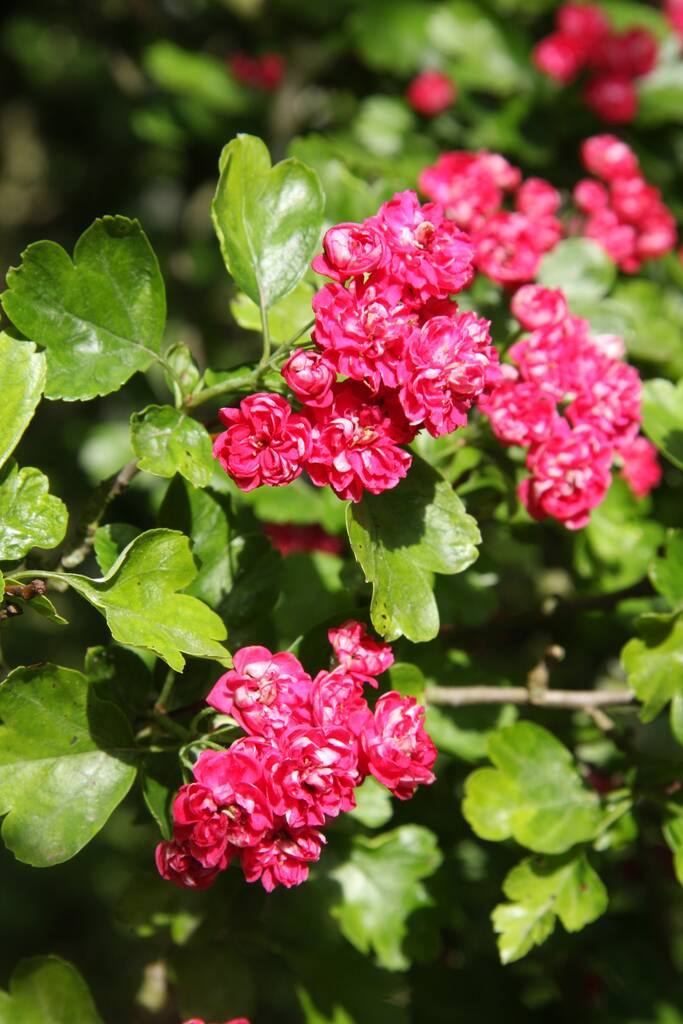Crataegus x media ‘Paul’s Scarlet’ is a deciduous ornamental tree belonging to the Rosaceae family. A cultivar of Crataegus laevigata, it was developed specifically for its striking floral display and remains one of the most popular hawthorns in UK gardens.
The tree is celebrated for its masses of double crimson-red flowers, which appear in late spring. These rose-like blossoms cluster along the branches, creating a spectacular burst of colour that transforms the tree into a dramatic garden feature. The flowers are long-lasting and attract pollinators, making them valuable for biodiversity as well as aesthetics.
Beyond its flowering season, Paul’s Scarlet offers further seasonal interest. In autumn, the tree produces clusters of bright red berries, known as haws, which are enjoyed by birds and small mammals. This wildlife-friendly quality adds ecological value while maintaining decorative appeal. The leaves, dark green in summer, turn shades of yellow before dropping, completing its cycle of seasonal colour.
The overall shape of the tree is another attractive feature. It develops a dense, rounded crown that provides excellent shade and privacy, making it a good choice for screening or creating a focal point. This form, combined with its moderate growth rate, ensures it can be integrated into a wide variety of garden designs, from traditional to modern.
Crataegus x media Paul’s Scarlet typically reaches 6–8 metres in height and spreads 4–6 metres over ten years. Its manageable size makes it suitable for medium to large gardens, where it can serve as a specimen tree, part of a mixed planting, or as a street tree in urban settings. Its tolerance of pollution and adaptability to different soils has also contributed to its use in public landscapes.
Caring for Paul’s Scarlet is straightforward. It thrives in well-drained soil and adapts to a wide range of conditions, including clay and chalk. Full sun to partial shade is preferred for best flowering. Once established, it is hardy and resilient, with good resistance to most weather conditions. Pruning should be carried out after flowering if shaping is required, but generally, the tree maintains a naturally balanced form without heavy intervention.
This cultivar has a long history of ornamental use and remains a reliable favourite due to its combination of beauty, durability, and wildlife value. Its flowering display alone makes it highly desirable, while its berries, dense crown, and seasonal transformations ensure year-round contribution to the garden.
Overall, Crataegus x med Pauls Scarlet Tree is an excellent choice for gardeners seeking a decorative and practical tree. With its double crimson blooms, autumn berries, and hardy nature, it brings lasting charm and structure to outdoor spaces.
The Crataegus x med Pauls Scarlet Tree is a medium-sized ornamental hawthorn with a rounded, dense crown. After around 10 years of growth, it generally reaches a height of 6–8 metres with a spread of 4–6 metres, giving it a balanced yet substantial presence in the garden.
During late spring, the tree is covered in clusters of striking double crimson-red flowers resembling small roses. These blooms create a spectacular floral display that dominates the landscape. As summer fades into autumn, bright red berries appear, adding another layer of visual interest while providing food for birds and other wildlife.
The foliage is dark green during the growing season, later turning yellow before falling, contributing to its multi-seasonal value. Its dense crown not only offers shade and privacy but also enhances its role as a feature tree. Practical, wildlife-friendly, and decorative, it is ideal for gardens and streetscapes.





